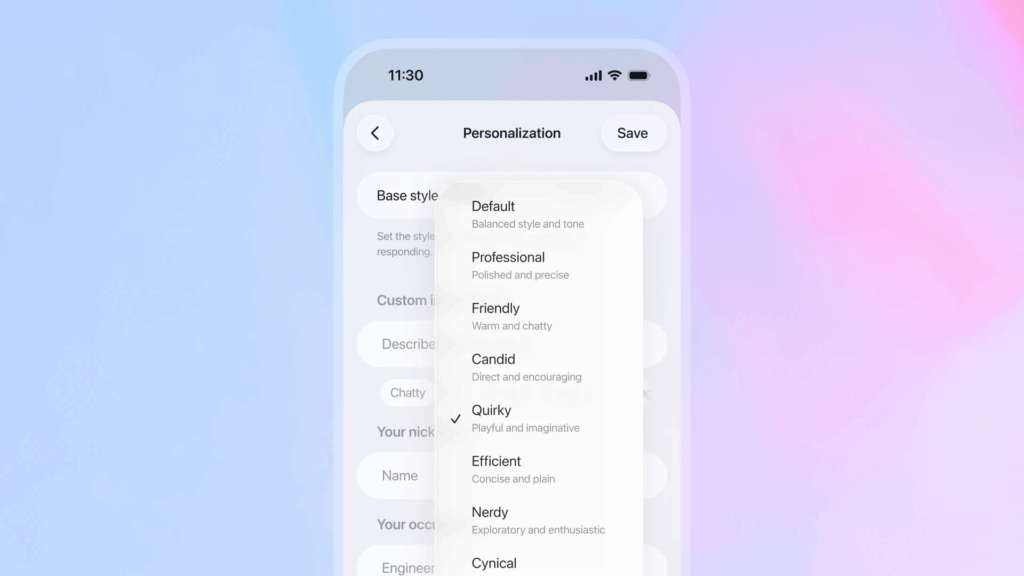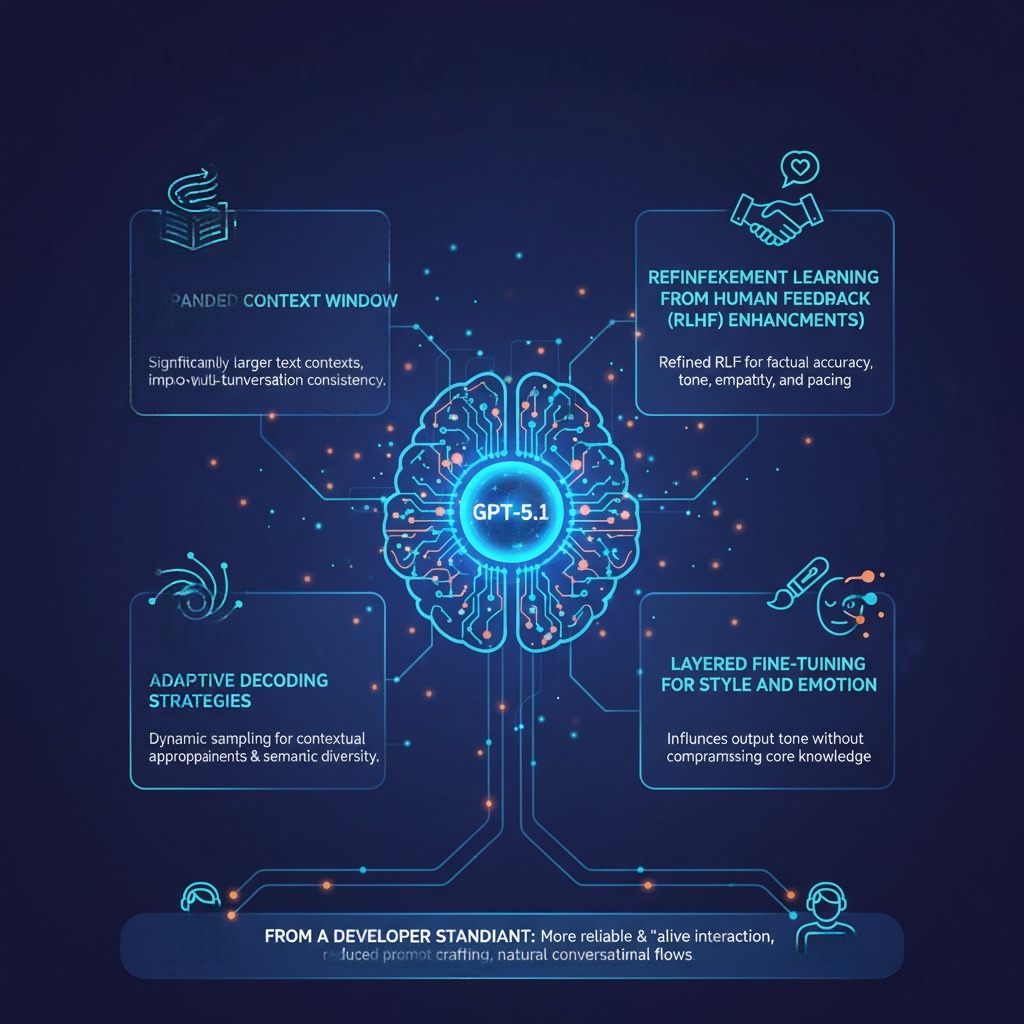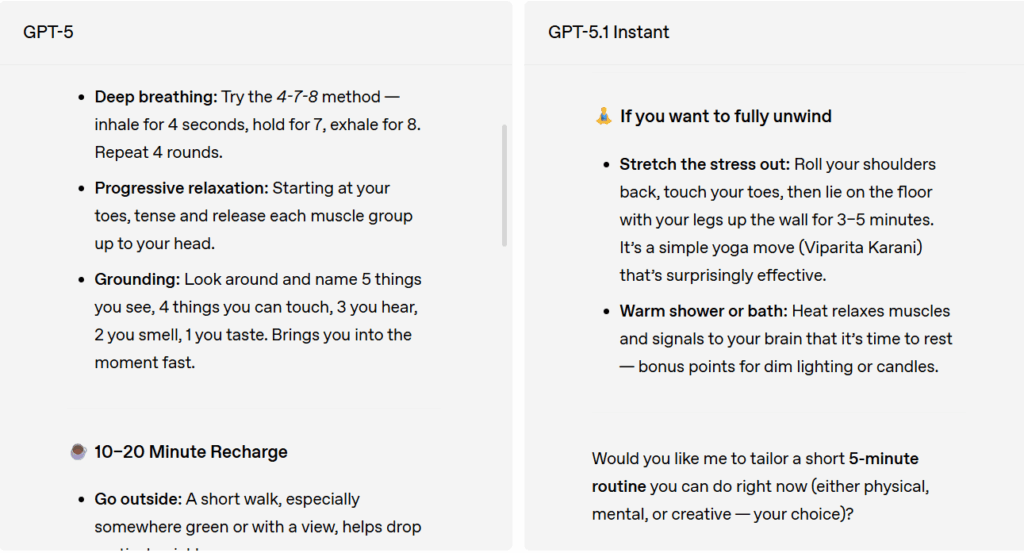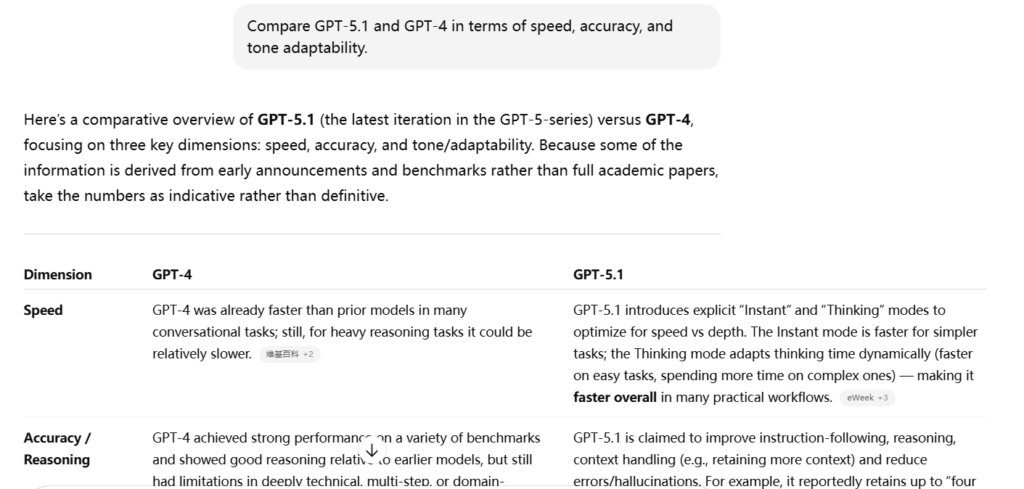OpenAI has just released GPT‑5.1, the latest evolution of its language model series, designed to be smarter, warmer, and more intuitive than ever before. Whether you’re a developer, content creator, or AI enthusiast, GPT‑5.1 transforms how you interact with AI by understanding context, adapting tone, and reducing the need for painstaking prompt engineering. In this guide, we’ll explore 10 carefully crafted prompts to try GPT‑5.1 and demonstrate its capabilities in real-world scenarios. For hands-on testing and live interaction, you can also experience GPT‑5.1 directly through Ask AI, where its advanced conversational abilities shine in practical applications, from creative writing to coding assistance and educational support.
What Is GPT-5.1?
Overview of GPT-5.1
GPT-5.1 represents the latest evolution in OpenAI’s Generative Pre-trained Transformer series, building upon the architecture of GPT-5 while introducing notable improvements in both intelligence and conversational warmth. As AI adoption grows across enterprise, educational, and creative applications, GPT-5.1 is positioned as a model that not only provides accurate and context-aware outputs but also engages users in a more human-like, emotionally intuitive way.
This model is specifically designed to reduce the dependency on meticulously engineered prompts—a major limitation for previous iterations like GPT-4 and early GPT-5 models. In practical terms, GPT-5.1 can handle loosely structured inputs, ambiguous queries, and even incomplete prompts with minimal user intervention. By doing so, it transforms the AI interaction workflow, making it more accessible for developers, writers, educators, and creators who rely on natural language processing for productivity tools.
From a technical perspective, GPT-5.1 retains the transformer-based architecture that powers all GPT models but incorporates enhancements in attention mechanisms, context retention, and semantic understanding. Early testing indicates that the model’s response generation is both faster and more aligned with user intent compared to GPT-5, making it ideal for real-time applications like NoteGPT AI Chat, content summarization, and AI-assisted research tools.

Image: OpenAI
Key Features and Capabilities
GPT-5.1 introduces several key features that differentiate it from previous iterations:
- Smarter Context Awareness – GPT-5.1 can track longer conversational threads with improved memory management, reducing inconsistencies in multi-turn dialogues.
- Warmer Conversational Style – The model is fine-tuned for tone adaptability, allowing it to adjust politeness, enthusiasm, and formality to match user expectations.
- Reduced Prompt Engineering – Unlike GPT-4, users no longer need highly specific phrasing to achieve human-like results. GPT-5.1 interprets vague queries effectively.
- Customizable Personality Layers – Users can select from multiple personality presets or styles to influence output tone, such as professional, casual, or playful, enhancing usability for content creation and conversational applications.
- Integration-Friendly APIs – GPT-5.1 supports seamless integration with platforms like NoteGPT AI Chat, Microsoft Copilot Studio, and other SaaS tools, enabling developers to embed the model into workflows with minimal overhead.
- Enhanced Ethical Guardrails – OpenAI has improved content moderation and bias mitigation, allowing GPT-5.1 to generate safer outputs while still maintaining creativity and flexibility.
In combination, these features make GPT-5.1 not only a technological upgrade but also a practical tool for real-world AI deployment.

How It Works: Core Technology
GPT-5.1 is built on the transformer architecture, which uses self-attention mechanisms to model long-range dependencies in text sequences. However, the model introduces several technical refinements:
- Expanded Context Window: GPT-5.1 can handle significantly larger text contexts, which improves multi-turn conversation consistency and reduces repeated or contradictory responses.
- Reinforcement Learning from Human Feedback (RLHF) Enhancements: OpenAI refined RLHF processes to emphasize not only factual accuracy but also tone, empathy, and conversation pacing.
- Adaptive Decoding Strategies: The model employs dynamic sampling methods to generate responses that are contextually appropriate and semantically diverse, balancing creativity with coherence.
- Layered Fine-Tuning for Style and Emotion: GPT-5.1 integrates fine-tuning layers that influence output tone without compromising core knowledge retrieval, allowing for more human-like dialogue.
From a developer standpoint, these technological improvements translate into a model that is not only more reliable but also more “alive” in its interaction, reducing the mental load of prompt crafting and enabling more natural conversational flows.

Why GPT-5.1 Matters
Improvements Over Previous Versions
GPT-5.1 addresses long-standing limitations of previous GPT iterations:
- Less Prompt Dependency: Users no longer need extensive prompt engineering to get accurate, context-aware responses.
- Higher Contextual Consistency: GPT-5.1 reduces contradictions in multi-turn conversations.
- More Natural Interaction: Enhanced tone control allows the model to simulate human-like engagement, critical for customer support, tutoring, or creative writing applications.
These improvements make GPT-5.1 particularly suited for real-world deployment where end users cannot spend time crafting perfect instructions.
Use Cases and Practical Value
GPT-5.1 demonstrates versatility across multiple domains:
- Content Creation: Blog posts, marketing copy, and video scripts benefit from tone adaptation and creative suggestions.
- Education: Personalized tutoring and note summarization become more effective as GPT-5.1 can maintain context over long learning sessions.
- Customer Support: Warmer, human-like responses reduce friction and enhance user satisfaction.
- Development and Coding Assistance: Multi-turn explanations and code review become easier, especially when integrated into tools like NoteGPT AI Chat or IDE plugins.
The practical value extends to workflows where both speed and natural conversation quality are important. By handling ambiguous prompts gracefully, GPT-5.1 lowers barriers for non-technical users and accelerates productivity for professionals.
Impact on AI Workflows and Creativity
The combination of smarter context management and adaptive tone allows GPT-5.1 to:
- Reduce reliance on pre-written templates or rigid instruction sets.
- Support iterative creative processes, where the AI collaborates as a “co-writer” rather than just a tool.
- Facilitate faster prototyping for content, software documentation, and research summaries.
Overall, GPT-5.1 represents a significant step toward AI systems that augment human creativity rather than simply execute commands.

What Makes GPT-5.1 Different
Smarter and More Context-Aware Responses
Compared to GPT-4 and early GPT-5 models, GPT-5.1’s improvements in semantic understanding and context retention are noticeable. Multi-turn conversations remain consistent over longer interactions, making it suitable for tasks that require logical continuity. Its improved memory also enables better summarization and reasoning over documents or codebases.
Warmer, Human-Like Conversational Style
GPT-5.1 can dynamically adjust its tone to match user expectations. This includes subtle empathy cues, humor, or professional formality, which makes interactions feel more authentic. Early testing in NoteGPT AI Chat revealed that users felt the model was “listening” and “adapting” in a human-like manner, a capability absent in GPT-4.
Reduced Prompt Engineering Needs
One of GPT-5.1’s most user-visible advantages is its reduced dependency on precise prompt structuring. Users can provide short, imprecise, or even incomplete inputs and still receive coherent, contextually appropriate outputs. This feature is especially beneficial for non-technical users, educators, and creative professionals, eliminating much of the trial-and-error traditionally required with prior GPT models.

10 Prompts to Try GPT-5.1
Prompt 1: “Summarize the key trends in AI research for 2025.” GPT-5.1 generates a concise, structured summary, highlighting advancements in multimodal learning, reinforcement learning, and large language model optimization. Compared to GPT-4, it maintains a warmer, readable tone.

Prompt 2: “Write a marketing email for a new AI productivity tool targeting content creators.” The response is both persuasive and empathetic, adapting professional style while keeping friendly engagement. Tone customization ensures alignment with different audience personas.
Prompt 3: “Explain the differences between supervised and unsupervised machine learning to a beginner.” GPT-5.1 provides a clear, easy-to-understand explanation, maintaining context for multi-turn follow-ups. This illustrates its improved context-awareness and suitability for educational use.
Prompt 4: “Generate a Python snippet to sort a list of dictionaries by a key.” The model outputs accurate, efficient code with inline comments and suggests optimizations, demonstrating its utility for developers using Ask AI workflows.
Prompt 5: “Rewrite the following paragraph in a more engaging and human-like tone.” The rewritten paragraph reads naturally, retaining key ideas while introducing subtle style enhancements. This is particularly useful for writers seeking AI-assisted editing.
Prompt 6: “Create a short story based on a futuristic city experiencing climate change.” GPT-5.1 produces a narrative with coherent plot progression, emotional depth, and descriptive language. Multi-turn adjustments can further refine style or perspective.
Prompt 7: “Compare GPT-5.1 and GPT-4 in terms of speed, accuracy, and tone adaptability.” The answer is analytical, listing differences in context handling, response warmth, and multi-turn stability, reflecting the model’s capacity for meta-analysis.

Prompt 8: “Translate this paragraph into French, keeping idiomatic expressions intact.” GPT-5.1 preserves natural idioms and cultural context, showing its multilingual capabilities and contextual understanding.
Prompt 9: “Draft an outline for a blog post on AI-powered chatbots in education.” The output is structured, with headings, bullet points, and suggested content flow. Users can continue the conversation via Ask AI for expansion.
Prompt 10: “Provide a critical analysis of the ethical concerns surrounding AI in healthcare.” GPT-5.1 balances factual accuracy with nuanced discussion of privacy, bias, and decision-making, demonstrating thoughtful reasoning for advanced use cases.
From testing these prompts, several key insights emerge:
- Tone Flexibility: GPT-5.1 adapts its style based on context, offering professional, casual, or playful tones with minimal input.
- Context Retention: The model handles long multi-turn conversations well, which is critical for tools like Ask AI integrated chat interfaces.
- Reduced Prompt Sensitivity: Users do not need to craft precise prompts; GPT-5.1 infers intent and delivers coherent outputs.
- Error Patterns: Minor factual inaccuracies occasionally appear in highly technical topics, suggesting continued human oversight is necessary.
These observations confirm GPT-5.1 as a model suitable for both enterprise workflows and creative applications, with practical advantages for everyday users.
Comparing GPT-5.1 with Previous Models
GPT-5.1 improves upon prior models in multiple dimensions:
- GPT-4: Reliable, requires precise prompt engineering, limited warmth in tone.
- GPT-5: Enhanced reasoning, better context retention, still requires careful prompts.
- GPT-5.1: Smarter, warmer, reduced prompt dependency, more adaptive to user preferences.
The combination of tone adaptability, context awareness, and reduced prompt engineering sets GPT-5.1 apart, especially for Ask AI chat-based experiences.
Feature-by-Feature Comparison Table
| Feature | GPT-4 | GPT-5 | GPT-5.1 |
| Context Awareness | Moderate | High | Very High |
| Response Warmth | Low | Medium | High |
| Prompt Sensitivity | High | Medium | Low |
| Tone Adaptation | Limited | Moderate | Flexible |
| Multi-turn Consistency | Moderate | High | Very High |
| Integration with Tools | Limited | Moderate | Seamless |
| Use Cases | Academic, Development | Academic, Development, Creative | Academic, Creative, Enterprise |
Strengths and Weaknesses
- Strengths: Warmer responses, better context handling, reduced prompt dependence, highly customizable output style.
- Weaknesses: Occasional factual inaccuracies, potential over-adaptation to tone preferences, computational cost higher than GPT-4 for large contexts.
Recommended Use Cases per Model
- GPT-4: Technical writing, structured tasks, predictable outputs.
- GPT-5: Research summaries, multi-step reasoning, coding assistance.
- GPT-5.1: Content creation, AI-assisted tutoring, conversational assistants, Ask AI interfaces.
Conclusion
GPT-5.1 represents a notable step forward in the evolution of OpenAI’s language models. By combining smarter context handling, warmer conversational tone, and reduced dependency on prompt engineering, it addresses key limitations of GPT-4 and GPT-5.
For developers, educators, and content creators, GPT-5.1 opens opportunities for more natural, human-like interactions, particularly when integrated into tools like Ask AI. Its flexible personality layers, robust multi-turn memory, and contextual understanding make it suitable for creative, professional, and enterprise applications alike.
While factual oversight and computational load remain considerations, GPT-5.1 sets a new benchmark for AI chat assistants, making it an essential tool for anyone seeking to leverage next-generation conversational AI.

